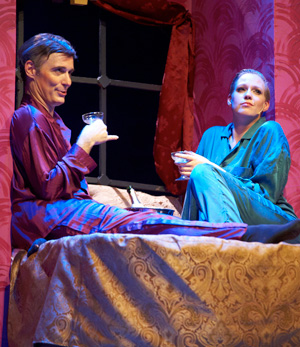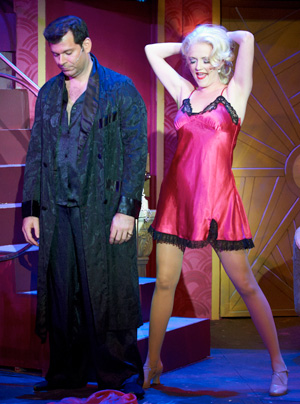There’s pink but no panther in Blake Edwards’ drag musical ‘Victor/Victoria’
ARNOLD WAYNE JONES | Life+Style Editor
jones@dallasvoice.com
I have to confess: I am not fully convinced Wendy Williams is really a woman. The first time I saw a promo for her talk show, I assumed it was on Bravo or Logo, and meant as a joke — an African-American Dame Edna.
That kind of gender confusion is at the heart of Victor/Victoria, the 1982 Blake Edwards movie later adapted into a 1995 stage musical about a Jazz Age British singer who becomes a Paris sensation only because everyone thinks she’s a he.
 It’s really nothing much different than My Fair Lady, where a Svengali-esque linguist crafts a guttersnipe into a lady, passing her off to society as something she isn’t. (Interestingly, both originally starred Julie Andrews.) Here, boozy gay lounge singer Toddy (Paul Taylor) takes wannabe cabaret act Victoria (Ashley Puckett Gonzales), creates a back-story for her as Victor, Poland’s greatest female impersonator, and wows everyone astonished that a man is so convincingly feminine. Along the way, there are questions of mistaken identity as American mobster King Marchand (G. Shane Peterman) finds himself uncomfortably attracted to “Victor.”
It’s really nothing much different than My Fair Lady, where a Svengali-esque linguist crafts a guttersnipe into a lady, passing her off to society as something she isn’t. (Interestingly, both originally starred Julie Andrews.) Here, boozy gay lounge singer Toddy (Paul Taylor) takes wannabe cabaret act Victoria (Ashley Puckett Gonzales), creates a back-story for her as Victor, Poland’s greatest female impersonator, and wows everyone astonished that a man is so convincingly feminine. Along the way, there are questions of mistaken identity as American mobster King Marchand (G. Shane Peterman) finds himself uncomfortably attracted to “Victor.”
In many ways, it’s a cutting-edge comedy of contemporary mores, with the film well ahead of its time, dealing with gender-bending in a surprisingly tolerant and off-handed (if slapstick-heavy) manner. In the post-Queer Eye, post-Drag Race era, it’s perhaps less edgy, but there’s some poignancy about acceptance underneath all the French farce door-slamming and bed-hopping.
Which is not to say the script is well written. I doubt you’ll find many people who will defend its structure. It’s messy, with few good buttons to end scenes, some parts that drag (not the good kind of drag) and a few puzzlingly-placed moments best abandoned altogether.
In Uptown Players’ production currently at the Kalita Humphreys, some — not all — of those weaknesses are less obvious. The score, a pastiche of 1930s-style jazz with Broadway flash layered on top, has few memorable hits (the best, “Le Jazz Hot,” was composed for the movie 30 years ago), but the band plays and the cast sings it all well, all on a fabulous and mobile set that makes great uses of the Kalita’s space.
What it doesn’t do especially well is conjure up both the glamour of Old Paris and the camp extravagance of the drag world. It would be hard to over-play the flamboyance of a Parisian nightclub in interbellum, but this one does. The “Victor-as-drag-queen” scenes don’t fully work because Victoria doesn’t look like a drag queen. She may be meant to be convincingly female, but RuPaul accomplishes that with glamazon femininity that still leaves you asking, “Could she be…?” Gonzales, in ill-fitting costumes and too-tasteful makeup, has no panache as Victor. Androgyny is one thing, but Victor needs dazzle to make King’s obsession with her seem authentic.
 She could learn a move or five from Whitney Hennen, who steals the show as King’s ditzy platinum blonde moll Norma. Bubbly and empty-headed as Lina Lamont, she turns eating a piece of chocolate from throw-away stage business into comic art, all with an excess that rises to the level of farce Edwards established in his Pink Panther movies. (The best scene, in fact, may be the dance of characters sneaking in and out of the bedrooms, which director Cheryl Denson choreographs beautifully.)
She could learn a move or five from Whitney Hennen, who steals the show as King’s ditzy platinum blonde moll Norma. Bubbly and empty-headed as Lina Lamont, she turns eating a piece of chocolate from throw-away stage business into comic art, all with an excess that rises to the level of farce Edwards established in his Pink Panther movies. (The best scene, in fact, may be the dance of characters sneaking in and out of the bedrooms, which director Cheryl Denson choreographs beautifully.)
In the wake of Dallas Theater Center’s recent awesome production of Cabaret — and Uptown’s own high-bar-setting Next to Normal — Victor/Victoria seems incidental, though considered on its own, there’s much to enjoy, especially as a respite from the August heat. Here life is a cabargay, old chum. Come to the cabargay.
This article appeared in the Dallas Voice print edition August 9, 2011.














